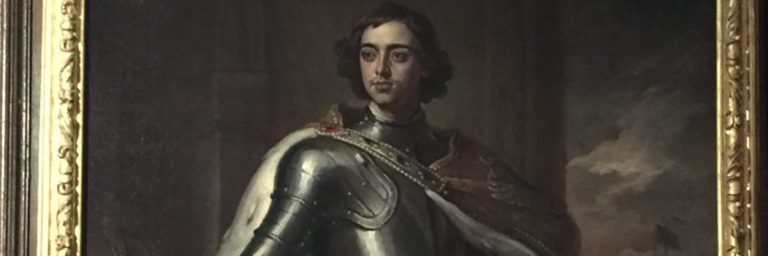Pick up a map of Europe. We recommend the National Geographic Visual Atlas of the World, 2nd Edition: Fully Revised and Updated. You will notice how Sweden dominates the Baltic Sea, particularly if you consider that Finland was part of Sweden until 1809 CE. In fact, the Gulf of Finland looks like an inviting gateway for Swedish Vikings to sail right into northern Russia. So, they did. While the Danes and Norwegians headed west to Britain, France and even America, the Swedes headed east. For a more thorough discussion of the legacy of the Vikings in western Europe, please refer to the Cruisereader articles on Baltic cruising.
The story as we know it comes from The Primary Chronicle of the Rus people, who came from Sweden, settled the Veliky Novgorod region south of current-day St. Petersburg, and began the first of the two major Russian dynasties, led by Prince Rurik of Novgorod, in 864 CE. They called themselves “Varangians” and they started to make a big impression on the Slavic world.
The transformation of this Viking foothold into Tsarist Russia is a story full of colorful characters, force of arms and will, and the basics of trade economics. It is tough to find reading dedicated to this part of Russian history, except for history text books. It may be better to get a book with wider scope. For background on the development of Kievan Rus and Imperial Russia, pick up The Russian Primary Chronicle: Laurentian Text and Medieval Russia’s Epics, Chronicles, and Tales
. For a concise, if that is possible, view of the complete Russian history, see A Short History of Russia: How the World’s Largest Country Invented Itself, from the Pagans to Putin
, or Russia: A Short History
.
Getting back to our map, focusing now on Russia, you will note that the sources of the Volga and Dnieper rivers are not far south of the lake near Veliky Novgorod. These massive and important rivers flow southward to the Caspian and Black Seas. They are highways through the heartland of the Russian and Belarus/Ukrainian countryside.
In the Ninth Century, anyone with a boat could have easily made it from Novgorod to Persia or Byzantium. The Varangians traveled the rivers in classic Viking fashion, trading and raiding, until they dominated the territories all the way to the river deltas and Constantinople.
The expansion of the Rurik Swedes was very fast. They established settlements along both rivers and dominated the Slavic residents. Thirty years after Rurik took charge, there was sufficient activity on the Dnieper for Rurik’s successor, Oleg the Seer, to move the capital to Kiev, in today’s Ukraine, founding Kievan Rus.
The Dnieper flows into the north shore of the Black Sea, which offered immediate access to Constantinople and the Mediterranean. That made it a very important trade route. The Varangians first dominated the river and then the Black Sea. With control of the Black Sea, they also controlled the delta of the Danube, with its trade access into Central Europe.
The Volga trade routes led to Persia and the Abbasid Empire. So, in very short order, this relatively new political power became a commercial power, as well. Most goods traveling from China to Europe actually went by way of the Baltic. Recent finds of coin caches in Sweden confirm the vibrancy of this trade. Controlling trade routes can only lead to one thing, which it did, and 28 years after Kievan Rus was born, Oleg was attacking Constantinople, one of the largest, most powerful cities in the world. That’s audacity!
Commerce along the three trade routes continued to grow. Sviatoslav the Brave expanded the empire eastward by conquering the strategic Khazar Khaganate, along the Volga River north of the Caspian Sea. Then he marched westward in to the Danube Valley of present-day Romania and Bulgaria. Though no one probably knew it, Sviatoslav actually had the largest European nation of his time. He even briefly moved the Rus Capital to the Danube Delta.
After a dose of fratricidal bickering, Vladimir the Great took the stage in 980 CE. Lest you fear he had forgotten his Viking heritage, he fled the perils of his ambitious brother and went back to Norway. He returned with a Varangian army, put his brother to flight and then death, and proceeded to “unite” the disparate realms of his kingdom through brute force. Once things settled down, he actually turned out to be a pretty able leader.
At this time, the Eastern Slavic countries had been visited by two Christian monks from Constantinople, Brothers Cyril and Methodius. They spread the good word in the vernacular Slavic languages and even translated the New Testament to make it easier to understand. At a time when the Roman church was still exclusively preached in Latin, the vernacular approach would win out. The brothers earned their sainthoods for their efforts. This is not the only time we have seen the vernacular carry the ecclesiastic day. Martin Luther’s Protestant message won popular support in the same manner in northern Germany. Both developments would have huge implications for the Christian religions throughout history.
Vladimir noticed that his tradition of Slavic pagan gods was not very useful. His grandmother, Olga, had converted to Christianity in Constantinople. According the Primary Chronicle, or Nestor’s Chronicle (after the monk thought to have written it in 1113 CE), Vladimir sent envoys around Europe to weigh the pros and cons of religious observance and to report back. When the envoys returned from their fact-finding, their analysis went something like this:
- The Muslims were too serious, and didn’t even drink.
- The Jews had no country of their own. Being kicked out of Jerusalem meant they were no longer in God’s good graces.
- The Roman Catholics spoke in Latin and their churches had no beauty. (This was obviously before the great Gothic and Italian cathedrals had been built.)
- The magnificence of Hagia Sophia in Constantinople suggested the Eastern Christians were on to something. (This was before the Great Schism)
The envoys recommended the Eastern Church. Vladimir agreed, got himself baptized, married the daughter of Emperor Basil II of Constantinople, and arranged mass baptisms of his subjects. While some historians have judged his conversion to be expedient, rather than heartfelt, they generally all agree that he made his entrance as a heathen king and his exit as a Christian king. For that, he earned his own sainthood, and another one for his grandmother Olga for good measure.
Emperor Basil, noting the resiliency of the Rus, hired a bunch of them for his personal Varangian Guards, sort of like the Pope’s Swiss Guards, only four hundred years earlier. So, Vikings provided the bodyguard for the Byzantine emperor, 1,500 miles away from their original turf.
Vladimir and his son, Yaroslav the Wise, built a number of large churches in Kiev and Novgorod. The establishment of the Christian church in Russia would have significant importance after the Great Schism of Catholicism and Orthodoxy and the subsequent fall of Constantinople to the Ottoman Turks in 1453.
Yaroslav the Wise, was clearly a lover, not a fighter. To form alliances throughout Europe, he married the grand-daughter of the Holy Roman Emperor. Then, he married his sister and three daughters off to the kings of Poland, Hungary, France and Norway. His son married the daughter of the Byzantine Emperor. It would be an interesting project to chart the resulting family tree throughout the royal families of Europe.
The Crusades opened new trade routes between east and west, loosening the grip held by the Rus. The kingdom went into a decline after several decades of family feuds and political infighting. Then, the unthinkable happened. Out of the unknown eastern lands, arriving almost unannounced, came the Golden Horde of Genghis Khan. Their armies were enormous. Their demands were not negotiable. They arrived, and they ruled.
All of Russia succumbed. Between 1237 and 1240, every Russian prince became a vassal. A remarkable story of its own, the Mongol Horde fashioned the largest empire on earth, from eastern Europe to China, encompassing and encouraging the development of the Silk Road. (For a fascinating history based on recent, post-Soviet journalism, see Genghis Khan and the Making of the Modern World.)
The Horde would rule almost like an absentee landlord for over 200 years. During this time, their presence in the southern Russian territories near the Black Sea was stronger than up north. The balance of influence among the Russian princes shifted from Kiev to Moscow and Tver (near Novgorod). In 1327, the prince of Tver staged a small revolt. The prince of Moscow allied himself with the Horde and helped put down the rebellion. For this, he was elevated to Grand Prince, and that is how Moscow rose to be the pre-eminent Russian city.
Finally, in 1476, Ivan III the Great, stopped paying his tribute and stared down his Mongol rival, Akhmat, Khan of the Great Horde, at the “Stand-off at the Ugra River”. The Ugra River is the border between Lithuania and Russia. The Great Khan was approaching from the west. Ivan held him off, and though no decisive battle was fought, the mutual retreat is still celebrated in Russia today because the Khan left and never came back. Ivan proceeded to fill the power vacuum and collected most of the former Russian territories back together.
As the Mongol Horde wilted from their historic apogee, retreating back towards the east, Ivan’s grandson, Ivan IV the Terrible, took the opportunity to conquer the Kazan Khaganate in central Asia. Then, with the assistance of the Cossacks of the southern Slavic regions, he took over Siberia. At the age of 16, he anointed himself the first “Tsar” (Russian for “Caesar”) of Russia. Historians pretty much agree this guy was nasty, in the tradition of Russian leaders. By the time he passed on, in 1584, he was the leader of the largest nation on earth. (Ivan the Terrible, by Henri Troyat)





